PinotFile: 9.24 May 5, 2013
|
Cork Dork
George Taber, To Cork Or Not To Cork
The Urban Slang Dictionary defines cork dork as a person who talks about wine too seriously. I suggest a second meaning: a person who collects and treasures old corks. I am an incurable collector so it is no surprise that I have amassed all the corks from the wines I have opened over the last forty years. Many people have a few corks rolling around in a kitchen drawer, but I take cork collecting more seriously. The corks have accumulated in trash bags in the attic because I could never figure out what to do with them. I know there are many clever craft projects that can be done with wine corks, including wreaths, bulletin boards, trivets, reindeer ornaments, garlands, key chains, place settings, cork mats and even a wall of corks. I heard of one cork aficionado who made a barge of 160,000 wine corks and sailed it along the Douro River in Portugal. None of these projects appealed to me, so the collection has taken on a prodigious size.
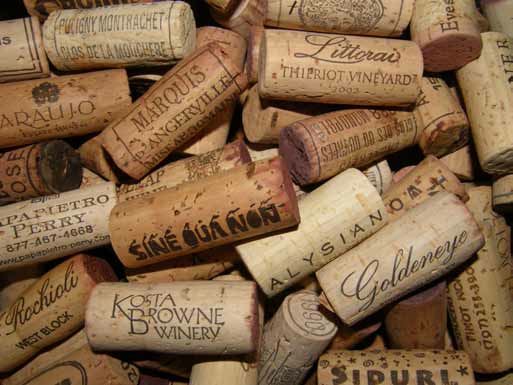 I recently had to clear out the attic to install new heaters, so I spent some time sifting through the corks. This turned out to be a very memorable, nostalgic undertaking. I found corks that brought back vivid memories such as the 1992 magnum of Williams Selyem Rochioli Vineyard Russian River Valley Pinot Noir I opened on my 50th birthday and the 1943 DRC La Tâche (my birth year) that I drank on my 60th birthday. Corks seem ageless and do not deteriorate over time. Natural corks are often branded with intricate designs and usually stamped with the producer’s name. Phone number, email address and vintage are less common Most corks do not have the date on them, but those that do can revive long lost experiences. I discovered, for example, Pinot Noir corks from 1990 El Molino, 1989 Etude, 1990 Sanford, 1991 Mount Eden Vineyards, 1985 Calera (the first case of Pinot Noir I ever bought), 1994 Au Bon Climat, 1992 Domaine Drouhin Oregon and 1993 Beaux Freres among others. Among dated corks, Kistler Vineyards was a favorite (22 cases of corks, mostly Chardonnay, 1988-2005).
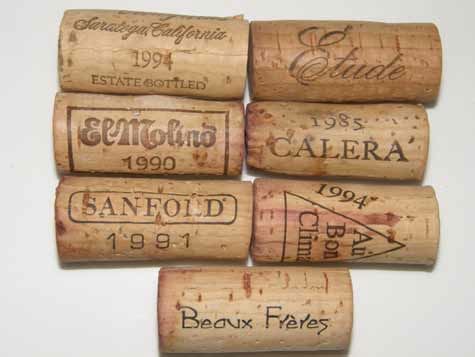
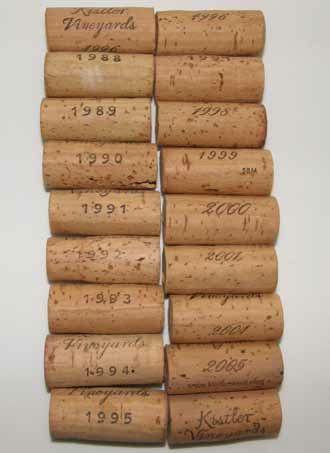 Many non-dated, very old corks were found from iconic producers such as Joseph Swan Vineyards, Robert Stemmler, Stony Hill, Hanzell, Saintsbury, Ponzi, Schug Cellars, Williams Selyem, Gary Farrell and David Bruce. I found that I drank my fair share of Rochioli & J. Rochioli (10 cases of corks), Gary Farrell (18 cases of corks) and Williams Selyem (32 cases of corks) Pinot Noir.
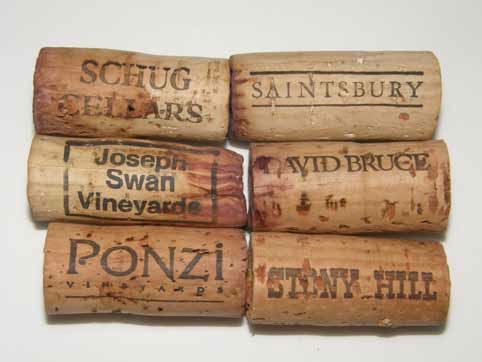
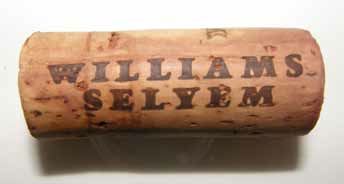 I had corks from Domain Drouhin Oregon from 1988 through 2010 (22 vintages), and 12 cases of Chalone Vineyard Pinot Noir corks from 1974 through 1994 (I was a Chalone shareholder).
 There were 26 cases of Champagne, Champagne magnum and assorted large format corks, almost all undated, but there was a dated 1961 Krug, 1976 Champagne Deutz, and 1979 Perrier-Jouët cork. Burgundy corks are particularly appealing as they are more wordy, beautifully designed, and often with the words, “Mise Au Domaine” on the cork.
 The first reference to cork dates to 3000 B.C. in China, where cork was used as part of fishing equipment. According to George Taber in To Cork or Not to Cork (2007), “No one knows exactly when the first person put the first cork in a wine container.” The Greeks in the 5th century used corks occasionally to close wine jugs and the Romans also used cork as a stopper, by itself and coated with pitch, but corks were not the closure of choice in ancient days. According to Taber, corks have been found in Roman shipwrecks dating from the fifth century B.C. to the fourth century A.D.. Professor Vernon Singleton of UC Davis believes the Romans were the first to use cork to protect wine from air. It was not until the 17th century, when glass bottles were first made with more uniform openings, that cork became the standard closure for wine bottles. The use of cork to stopper glass containers started first in England and spread to Continental Europe. A common misconception is that cork was first adapted as a stopper in 1670 by the French Benedictine monk Dom Perignon for the sparkling wine of his Hautvilliers’ monastery. The truth is that the English had been bottling sparkling wine with cork in London before Dom Perignon’s supposed discovery. Once cork was in regular use, a good way to remove the cork was needed. According to Taber, the first English patent for a corkscrew was given to Samuel Henshall, a member of the clergy, on August 24, 1795. This produced the marriage of bottle, cork and corkscrew, and for the first time, a reliable way to age wine.
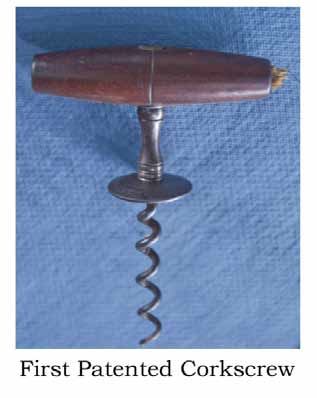
I also have an interesting collection of capsules. Like I said, I an inveterate collector. I haven’t figured out what to do with them either.
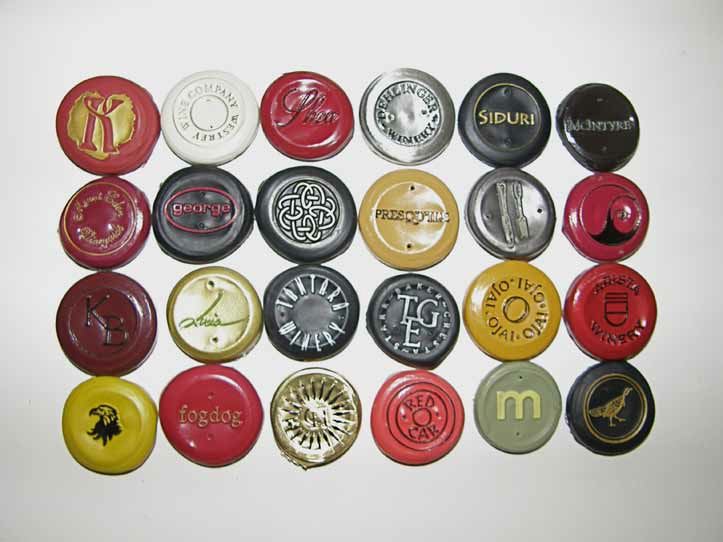
Etude: Inspired Wines of the CarnerosEtude is a pioneering winery in the Napa Carneros region started by noted winemaker Tony Soter in 1980. The initial release was a Napa Valley Cabernet Sauvignon, but Soter quickly moved into Carneros Pinot Noir (first release was in 1982), Napa Valley Pinot Blanc, Napa Valley Merlot, Carneros Pinot Gris, Vin Gris of Pinot Noir, and a Brut Rosé sparkling wine.
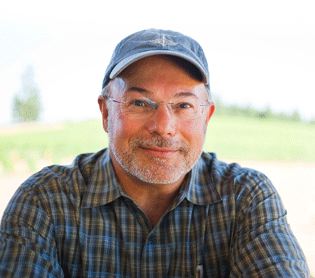 The winery was initially an underfunded proprietary side project that Soter indulged in while he worked his day job as a consulting winemaker to several of Napa’s most high profile wineries including Araujo Estate, Dalle Valle, Niebaum-Coppola, Shafer, Spottswood and Viader. Soter owned no vineyards, but developed contracts with growers that allowed him to farm his blocks to his own strict specifications. He was one of the first consultants in the Napa Valley to buy grapes by the acre in contrast to the common practice of the time of buying grapes by the ton. It was an encounter in Soter’s cellar with Madame Lalou Bize-Leroy in 1980 that led Soter to name his new wine company Etude. Lalou was assessing Tony’s first Pinot Noir, and her comments implied that Tony needed to improve his winemaking approach. Etude was an appropriate name since it is derived from the French word, étude, meaning “study, and in music to a composition designed to improve the technique of the player.” Soter would say in 2004 (Wine & Spirits), “Pinot Noir is the best and most transparent wine vehicle with which to ‘study’ the craft and this has been a life long and humbling pursuit....I like to say I was in pursuit of the wisdom of ancestors I never had.” Soter’s wines quickly attracted considerable attention from the wine press and Pinot Noir aficionados. He was fanatical about quality and typically he sold off anonymously more than 20% of the wine he produced in bulk. By 1999, Soter was able to end his consulting career to concentrate full time on Etude and develop estate vineyards. He eventually returned to his roots (he is a Portland native) to establish a second Pinot Noir project in the Willamette Valley of Oregon. Etude was sold to Fosters Wine Estates in 2001, and the corporation provided the capital to build a new winery, refurbish vineyards, and expand production. Soter made his last wines at Etude in 2002, and moved to Oregon permanently to devote himself to Soter vineyards in the Yamhill-Carlton District at Mineral Springs Ranch. He still consults at Etude, assisting Jon Priest who joined Etude as winemaker in 2005. Until 2004, Etude Pinot Noir was sourced from selected Carneros sites and drew its character from clay-heavy soils that created high extract and a firm tannic structure. The wines since then have been produced exclusively from Etude’s Estate Vineyard located in the northwestern corner of the Carneros appellation in the Sonoma Carneros region. Although most of the soils in Carneros are clay-based, the Etude Estate Vineyard is planted in rocky, volcanic soils that are extremely well-drained. Above ground, the extreme western location close to the Pacific Ocean leaves the vines exposed to the cool and windy weather that Carneros is known for. The vineyard is planted to twenty Pinot Noir clones. One of Soter’s pet projects was the resurrection of “heirloom clones” of Pinot Noir. The heirloom clones are rare suitcase Pinot Noir clones planted in small vineyard test blocks. He compiled a library of rare vine material from growers’ vineyards and experimental plots. Because many of these selections did not produce consistently large crops and the bunches were small and irregularly shaped, they were not considered economically viable and often ignored by growers. The first vintage of Etude Heirloom Pinot Noir was 1995, consisting of 95 cases, and was the first unfiltered wine produced at Etude. The wine in the early years was a blend from several vineyard sources, varied each year, and was aged in about 60% new French oak. The best barrels were chosen and held for aging of up to 18 months. Heirloom Pinot Noir was initially a case of marketing trumping reality because the wines were not always composed of “heirloom clones.” Despite this, the wines were of superior quality, offering an unusual expression of Pinot Noir unlike any other Pinot Noir made in California at the time. In 2005, Etude dedicated a 7-acre block of the Estate Vineyard to ten different selections of heirloom Pinot Noir to serve as a library as well as a source for Heirloom Pinot Noir, insuring that all the fruit was estate in origin. I have tasted a number of partial verticals of Etude Carneros Pinot Noir and Etude Heirloom Pinot Noir. In 2005, I tasted Etude Carneros Pinot Noir from 1992 to 2003 (Volume 5, Issue 10). In 2009 (Volume 7, Issue 12), I tasted the 2003 to 2006 vintages of Etude Carneros Pinot Noir. In this issue I re-tasted some older vintages and brought the vertical up to the current 2010 release. Also in 2009 (Volume 7, Issue 12), I reviewed nine vintages of Etude Heirloom Pinot Noir (1996-2005 absent 1999) as well as recent vintages of the limited release Etude Deer Camp and Etude Temblor Pinot Noirs. In this issue, I have revisited several vintages of the Etude Heirloom Pinot Noir. Vertical tastings are valuable for they allow the taster to examine a winery’s large body of work and with this experience comes a true appreciation of the talent and devotion winemakers offer to the wine enthusiast despite vintage variations. The Etude Heirloom Pinot Noir is darkly colored, concentrated and powerful, with a modestly muscular tannic structure, and features dark fruits with an earthy, savory tone. The wine is definitely not a mainstream Pinot Noir. The wine’s best drinking window is five to eight years. The Etude Carneros Pinot Noir is a consistent performer that ages well. Earthy, with firm but balanced tannins, this wine is like a jacket you always reach for: comfortable, nicely fitted and you feel good in it. Although ready to go upon release, the Etude Carneros Pinot Noir will hold for at least ten years in exceptional vintages. Etude Pinot Noirs are benchmarks for the Carneros appellation. The Etude Carneros Pinot Noir is sold on the website and is in widespread retail distribution (often discounted). The Etude Heirloom Pinot Noir is a limited release sold through a mailing list and at the winery. Special single vineyard Pinot Noirs are offered as well. The tasting room at 1250 Cuttings Wharf Road in Carneros, just off Highway 121, is open daily from 10:00 to 4:30 with premium and reserve tasting and wine and food pairing (by reservation) offered Friday through Sunday. Visit the website at www.etudewines.com.
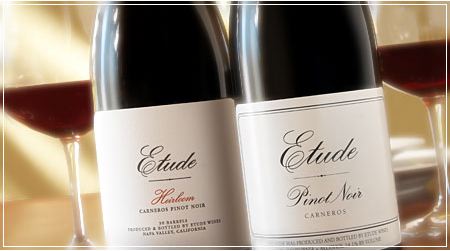
2002 Etude Carneros Pinot Noir 14.1% alc., magnum. · Medium reddish-purple color without bricking in the glass. Initial aromas of earth, leather, black tea and cigar box give way over time to more black plum fruit. Very soft and smooth on the palate with restrained tannins and a delicious array of dark red and black fruits accented with notes of tea leaves, spice and oak. Juicy and satisfying with plenty of fruit holding court on the finish. Very good. Drink up.
2003 Etude Carneros Pinot Noir 14.2% alc., 8,200 cases, magnum, $40 (750 ml). · Medium reddish-purple color in the glass. Aromas of blackberry jam, oak cask, clay and cigar box. A charming wine with fresh fruit expression including flavors of dark red and black berries and black cherries with a hint of dark caramel. Very soft and silky on the palate. Not quite the intensity of the 2002 vintage, but still sumptuous. Very good. Drink up.
 2004 Etude Carneros Pinot Noir 14.2% alc., 8,000 cases, $42. · Moderately dark reddish-purple color in the glass. Aged bouquet of black fruits, cigar, dried rose petal, and a Prada leather coat. Fresh flavors of blackberries, black raspberries with an earthy, grilled beef undertone. Some savory spice shows up as well. Modest in richness, but highly flavorful with balanced tannins and a pleasing finish. Has aged beautifully. Very good. Drink up.
2006 Etude Carneros Pinot Noir 14.2% alc., $42. · Medium reddish-purple color in the glass. Very appealing nose offering an array of dark red and black stone fruits, spice and rose petal. Mid weight flavors of black cherries and cassis with a riff of beefy mushrooms. Balanced firm, dry tannins with a very dry, flavorful finish. Very good. Drink up.
2008 Etude Carneros Pinot Noir 14.6% alc., $42. · Moderate reddish-purple color in the glass. Shy aromas of black cherries that take on intensity over time in the glass. More body and fruit presence in this vintage with a plush core of dark red and black fruits wrapped in tarry, vanilla-laced oak. Finishes with a touch of heat. Decent. Drink up or hold.
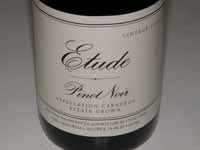 2009 Etude Carneros Pinot Noir 14.4% alc., $42. · Moderately light reddish-purple color in the glass. Shy aromas of cherries and dried herbs including sage. A little rustic, but with an appealing attack of black cherry and blackberry fruits, holding on with impressive persistence on the spicy, beefy, black cherry driven finish. Noticeably seamless. Very good. Drink up or hold.
2010 Etude Carneros Pinot Noir 14.5% alc., $42. · Moderately light reddish-purple color in the glass. Very muted nose despite intensive swirling in the glass. The black cherry core is lighter in this vintage but flavorful and this wine has a more noticeable cut of citrusy acid on the finish. Nicely spiced with subtle oak notes in the background and a fresh cherry ending. At this stage, the flavors trump the nose, and I would hold off another six months. Good. Hold.
2000 Etude Heirloom Carneros Pinot Noir 14.9% alc., 500 cases, $70. · Moderately light reddish-purple color with slight edge bricking in the glass. Aromas of cigar box and soy sauce. Middleweight flavors of dark berries, currant, and plum with an earthy undertone. Definitely showing its age, but still offers some enjoyable fruit and respectable length on the finish. Good. Drink up.
2001 Etude Heirloom Carneros Pinot Noir 14.5% alc., 850 cases, $70. · Medium reddish-purple color in the glass. Aromas of black cherries, raspberries and flower garden. Soft on entry and exit with a very rich and tasty core of black cherry, black raspberry and black plum fruits accented with notes of savory herbs and grilled mushrooms. Still sporting a firm tannic backbone, finishing with impressive length. Very good. Peaked, drink up.
2002 Etude Heirloom Carneros Pinot Noir 14.6% alc., 750 cases, $70. · Moderately dark reddish-purple color in the glass. The nose is rich with very ripe stone fruit and dark berry aromas with a slight medicinal note. Discreetly concentrated black plum flavor with a hint of savory herbs and Asian 5-spice. Finishes with drying tannins. Good. Drink up.
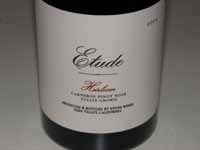 2004 Etude Heirloom Carneros Pinot Noir 14.6% alc., 1,000 cases, $70. · Moderately dark reddish-purple color in the glass. Very expressive nose offering bright aromas of black cherries, sandalwood and spice. Delicious array of dark fruits, veering to the ripe side, with hints of sassafras, smoke and tea. Very silky on the palate with supple tannins and some finishing persistence. Clearly the best of the five Heirloom wines tasted today showing good power but great balance. Very good (+). Drink up or hold.
2005 Etude Heirloom Carneros Pinot Noir 14.6% alc., 1,091 cases, $90. · Medium reddish-purple color in the glass. Complex array of aromas including plum sauce, damp forest floor, herbs, mushrooms, spice and rose petals. Juicy and very tasty with middleweight flavors of black stone fruits and grilled mushrooms. Still sporting muscular tannins. Very good. Drink up or hold.
the Gardener: Got Organic Grapes?The husband and wife winemaking team of Chris Condos and Suzanne Hagins produces a line of red and white varietals from organic grapes exclusively at their Horse & Plow winery in Santa Rosa. The 2011 releases under Suzanne’s label, “the Gardener,” really caught my attention. There are many outstanding wineries with husband and wife winemaking teams so it would appear to be a formula for success despite the adage that spouses should not work together. Examples are WesMar Winery (Denise Selyem and Kirk Hubbard ), Teutonic Wine Co. (Barnaby and Olga Tuttle), Castoro Cellars (Niels and Bimmer Udsen), Ampelos Cellars (Peter and Rebecca Work), and Marcassin (Helen Turley and John Wetlaufer). Suzanne developed an interest in wine while working in fine restaurants in Charleston, South Carolina. She worked her first harvest in Pommard at Comte Armand and moved to California in 2000 to pursue a career in winemaking. After working at De Loach, David Bruce and Goldeneye wineries, she started a small Pinot Noir brand, Lutea. Seven years later, she launched the Gardener label with Horse & Plow. I first met Suzanne several years ago when she was making superb wines for B Vineyards & Habitat in Sebastopol, and I enjoyed several of her Pinot Noirs under the Lutea label over the years as well. Chris Condos attended University of California at Davis before beginning his career at Pine Ridge Winery. He launched Vinum Cellars in Oakville in 1997, and has been the consulting winemaker for Kathryn Kennedy since 1998. Together with Suzanne, Horse and Plow was launched in 2008. The special Pinot Noir reviewed here is sourced from a 1-acre block of the Scintilla Vineyard in Sonoma Carneros that Suzanne has worked with since 2005. The vineyard is farmed by Robert Sinskey Vineyards, a leader in organic and biodynamic viticulture. The wines are produced with native yeasts and malolactic fermentations, extended lees contact, exceptional cooperage and minimal handling. Deft winemaking and a gentle hand are evident in these superb wines. Chris and Suzanne feel that in addition to the environmental benefits of organic farming, the resulting wines show more varietal character and sense of place, and I agree. Current production for Horse & Plow Winery is 2500 cases annually. The labels are custom designed by family members, Florance Condos and Alan Crockett. Tours and tasting is by appointment at the winery in Santa Rosa. The wines are available through the website store at www.horseandplow.com. The website is one of the best designed and tasteful wine websites I have ever visited.
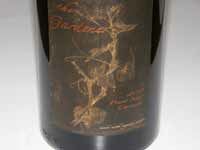 2011 the Gardener Carneros Pinot Noir 13.7% alc., pH 3.52, TA 0.62, 200 cases, $35. Scintilla Vineyard, clone 667. Vineyard Certified Organic by CCOF. Harvested at 23.5 Brix. 20% whole cluster. Aged 10 months in 25% new French oak barrels. Unfined and unfiltered. · Moderately light reddish-purple color in the glass. The aromas jump out of the glass with remarkable clarity, displaying notes of fresh black cherries and spice. Delicious core of perfectly ripened and well-spiced cherries and plums. The wine is impeccably balanced with supple tannins, and features a remarkably long, cherry driven finish. My notes are filled with superlatives. This wine is like the girl you could never have but always wanted.
2011 the Gardener Don Miguel Vineyard Russian River Valley Chardonnay 13.5% alc., pH 3.40,TA 0.64, 200 cases, $30. Made from organic grapes grown in Goldridge soil. See clone. Vineyard is Certified Organic by CCOF and farmed by Marimar Torres. Harvested at 22.0 Brix. 50% MLF. Aged 9 months sur-lee in 30% new French oak barrels. · Pale straw color and clear in the glass. Lovely aromas of lemon, pear, banana and almond. A transparent wine, unencumbered by oak, offering flavors of citrus and pear with a hint of roasted nuts in the background. Bright and very agreeable, light on its feet, with a lively acid backbone, and a tight, lemony finish. Very good.
Bravium: Relish the AcidityBravium, Latin for “reward, price or gift,” is a winery featuring traditional, minimalistic winemaking by proprietor Derek Rohlffs. Rohilffs is a graduate of University of California at Santa Barbara in Environmental Studies and completed his winemaking course work at University of California at Davis. He has made wine since 2000 and traveled to the wine regions of France, Italy and Australia to hone his craft. Derek told me he has been inspired by the work of Kevin Harvey and Jeff Brinkman at Rhys Vineyards and Jeff has been a significant influence on his winemaking.
 Bravium features vineyard-designated and appellation-designated Pinot Noir and Chardonnay. The winery is located on Treasure Island in the middle of San Francisco Bay. Vineyard sources include Signal Ridge Vineyard in the Mendocino Ridge AVA, the Beau Terroir Vineyard in Napa Carneros and other vineyards in Sonoma Carneros. Production is small (96 to 448 cases per wine) and the wines are sold direct to mailing list members and through select retail outlets with some restaurant placements. A portion of the profits from the sale of Bravium wines supports Sip & Give, Bravium’s charitable giving campaign. Sip & Give features a roster of worthy charities that are funded by the public’s votes (visit the webiste at www.bravium.com for more details). Simply put, Derek makes wine, you drink the wine, and together, you both sip and give. Derek is also a Member of the Cherokee Nation and Bravium is a registered TERO business. Tasting is available at Treasure Island Wines, 995 9th Street, Treasure Island. Open Saturdays and Sundays from 1:00 to 5:00. This was the first time I came across Bravium Pinot Noir and I was very impressed by the consistently high quality of each Pinot Noir bottling. The wines show deft integration of oak, judicious use of whole cluster fermentation, pleasant aromatics, flavor without weight, and bright acidity for refreshing drinking. Derek definitely has something going here and I would recommend the Pinot Noirs without reservations.
2011 Bravium Sonoma Coast Pinot Noir 14.4% alc., pH 3.51, TA 0.60, 96 cases, $34. From the Volamus Vineyard, located in the Petaluma Gap, and planted in 1999. Dense plantings of 115, 667 and Pommard. 100% de-stemmed, native fermentation, aged in 25% new 4-year air-dried Francois Frères oak barrels. Unfined and unfiltered. · Moderately dark reddish-purple color in the glass. Great nose with explosive aromas of black cherries, redwood and spice, holding up nicely over time in the glass. Very soft in the mouth and highly flavorful with a core of black cherry and black raspberry fruits, accented with notes of dark chocolate and spice, finishing with a refreshing edge of citrus-driven acidity. Ready to go now. Very good.
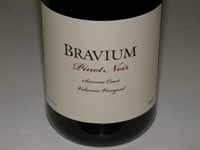 2011 Bravium Volamus Vineyard Sonoma Coast Pinot Noir 14.2% alc., pH 3.45, TA 0.61, 96 cases, $34. 4,500 vines on 3.5 acres. Clones 115, 667 and Pommard farmed sustainably. Hand pressed, 25% whole cluster, racked once after MLF, aged in 50% new 4-year air-dried Francois Frères oak barrels. Unfined and unfiltered. · Medium reddish-purple color in the glass. A more serious, complex wine that will benefit from more time in the bottle. The aromas open slowly in the glass to reveal hi-tone notes of dark berries, spice, forest floor and a hint of vanilla. Dark berries are the featured fruit with undertones of dark chocolate, clove and allspice, all wrapped in dry, chalky tannins, finishing with razor sharp acidity. A little more body, nuance and class than the Sonoma Coast bottling. Very good (+).
2011 Bravium Signal Ridge Vineyard Mendocino Ridge Pinot Noir 14.3% alc., pH 3.47, TA 0.61, 288 cases, $34. The vineyard is on a steep mountainside three ridges in from the Pacific Ocean at 2,642 feet elevation. Relatively shallow and rocky soils. Wide variety of clones and selections including Pommard and Swan. Yields 0.65 tons per acre. 16% whole cluster, 7-day cold soak. Native fermentation in one-ton fermenters. Aged 11 months in 33% new 4-year air-dried Francois Frères oak barrels. Unfined and unfiltered. · Moderately light reddish-purple color in the glass. Aromas of cherries, deep red rose petals and pine needle. Tasty with good intensity, featuring flavors of black cherries black raspberries and pomegranates with a hint of tea. Impeccable balance with mild tannins and juicy acidity, finishing with impressive intensity. Blossomed beautifully the following day from a previously opened and re-corked bottle, displaying a dreamy, velvety mouth feel and seductive flavors.
2011 Bravium Signal Ridge Vineyard Sundance Block Mendocino Ridge Pinot Noir 14.4% alc., pH 3.52, TA 0.60, 96 cases, $39. Yields 0.65 tons per acre. 100% de-stemmed, 7-day cold soak, native fermentation, aged in neutral French oak barrels. Unfined and unfiltered. · Moderately light reddish-purple color in the glass. Nicely perfumed with aromas of dark red cherries and berries, fruit bin and mushrooms. A little riper and more savory with flavors of black cherries, plum, spice and mushrooms. The tannins are soft and supple and the finish is juicy and appealing. Very good.
2011 Bravium Signal Ridge Vineyard Jackpot Block Mendocino Ridge Pinot Noir 14.3% alc., pH 3.49, TA 0.60, 72 cases, $39. Yields 0.65 tons per acre. 20% whole cluster, native fermentation, aged in 33% new 4-year air-dried Francois Frères oak barrels. 25% whole cluster, 7-day cold soak, native fermentation, aged in 66% new Francois Frères oak barrels. Unfined and unfiltered. · Moderately light reddish-purple color in the glass. Aromas of cherries, cassis, spice and oak. Redder fruits are featured on a mid weight frame. Light and juicy with supple tannins and a good finishing grip of acidity. Pleasant and easy to drink, but lacks a mid palate and finishing punch of fruit. Good (+).
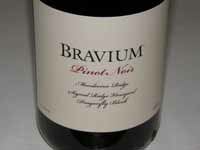 2011 Bravium Signal Ridge Vineyard Dragonfly Block Mendocino Ridge Pinot Noir 14.2% alc., pH 3.39, TA 0.634, 72 cases, $39. Yields 0.65 tons per acre. 25% whole cluster, 7-day cold soak, native fermentation, aged in 66% new 4-year air-dried Francois Frères oak barrels. Unfined and unfiltered. · Incredible nose that keeps pumping out aromas of fresh dark berries over time in the glass. Delicious core of black cherry and dark berry fruits, exotically spiced with a hint of toasty oak in the background. A seamless wine with powdery tannins and a finishing lift of decadent fruit that returns in waves for several encores. An exceptionally dreamy wine.
2012 Bravium North Coast Rosé Wine 12.3% alc., pH 3.27, TA 0.697, 84 cases, $19, screwcap. 98% Pinot Noir (Signal Ridge Vineyard) and 2% Chardonnay. Aged in both stainless tanks and neutral oak. Unfined. · Moderately light red color in the glass. Aromas of strawberry, cranberry, cherry, blood orange and floral tones. Soft and perfumey on the palate, with flavors of strawberries, cherries, and red hard candy. Very fruity in style with a subtle sweet character. Decent.
2010 Bravium Thomson Vineyard Napa Carneros Chardonnay 14.3% alc. pH 3.51, TA 0.6, 288 cases, $24. Clones 17, 76, 96 and 97. Aged in a combination of oak barrels and tanks. Partial MLF. Unfined. · Very light yellow color and clear in the glass. Aromas of lemon, nuts, honeysuckle and seasoned oak. Light, soft and delicately flavored, with notes of pear, hazelnut and caramel. A well-crafted, but very understated style that just didn’t grab my attention. Decent.
Rivers-Marie: 2010 & 2011 Reflect the Challenges of Farming on the EdgeReaders know that I have been a fan of the Pinot Noir wines from Thomas Brown and his Rivers-Marie label. I have enthusiastically reviewed practically every release through 2009. I haven’t spoken with Thomas about the 2010 and 2011 wines, but I have to believe that he was frustrated by the formidable growing seasons of 2010 and 2011 on the true Sonoma Coast where his vineyard sources are located. In spite of that, he managed to craft some exceptional wines, particularly in 2010, when vineyard sources managed to avoid the heat spikes of that vintage experienced in more inland winegrowing regions. The 2010 Sonoma Coast Pinot Noir (600 cases) and 2010 B. Thieriot Vineyard Sonoma Coast Chardonnay (180 cases) were not reviewed. The 2011 vintage was the tenth for Rivers-Marie. As indicated by the lower finished alcohol percentages in 2011, the growing season was very cool, fruit was hung longer than normal, grapes were picked at a lower average Brix than either 2009 or 2010 and ripeness was an issue. Brown did say in his newsletter, “The vintage (2011) produced the most delicate set of wines in our short history.” Summa Vineyard did not perform up to its customary high standards and an old vines bottling was not offered in 2011. Production was down about 500 cases in 2011 compared to 2010. The Sonoma Coast Pinot Noir(450 cases) and B. Thieriot Vineyard Sonoma Coast Chardonnay (185 cases) were not reviewed. Brighter days are ahead, for Brown touts the 2012 vintage in his last newsletter. Two new vineyards came on board including Ulises Valdez’s Manzanita Vineyard and Kanzler Vineyard. In 2012, Rivers-Marie surpassed 2,000 cases of Pinot Noir for the first time in its history. This will allow some new customers to be added from the waiting list for the first time in three years. Visit the website at www.riversmarie.com.
2010 Rivers-Marie Occidental Ridge Vineyard Sonoma Coast Pinot Noir 14.1% alc., 185 cases, $45. Aged in 60% new French oak barrels. · Moderately dark reddish-purple color in the glass. Ying (savory) and yang (fruit) nose offering scents of dark stone fruits, cinnamon spice, forest floor, pine, mushroom and oak. Plush, full and creamy on the palate featuring flavors of dark red berries and plums, finishing soft and intense with a good cut of acidity. The ripest and most concentrated wine in the 2010 lineup, but not weighty. One of the biggest Rivers-Marie wines ever and a magnet for fruit lovers. Very good.
2010 Rivers-Marie Silver Eagle Vineyard Sonoma Coast Pinot Noir 14.2% alc.,169 cases, $45. Aged in 40% new French oak barrels. Farmed by Ulises Valdez. Clone VR and 828. · Moderately dark reddish-purple color and hazy in the glass. Very brooding, with shy aromas of blackberry jam, black currant, and oak cask. Mid weight core of tasty black fruits backed by complimentary oak. The wine displays a soft, polished texture, balanced tannins, and a welcome cut of acidity on the finish. Very good.
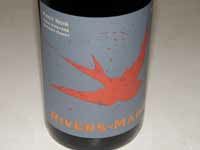 2010 Rivers-Marie Gioia Vineyard Sonoma Coast Pinot Noir 14.1% alc., 120 cases, $50. Aged in 80% new French oak barrels. Gioia is a 2-acre vineyard just west of Occidental on Joy Road, about a mile from Summa Vineyard as the crow flies. A mix of 115 and Pommard clones. · Moderate reddish-purple color in the glass. The most aromatic wine in the lineup, filling the glass with a perfume of fresh black cherries, raspberries, clove and other spices, and sandalwood. Discretely concentrated dark raspberry and cherry fruit flavors with a hint of brown spice and dark chocolate. The mid palate fruit is very exotic and striking in its vividness, persisting with uncommon clarity in a very juicy, splashy finish. Seamless, with modest tannins, and easy to dance with now.
2010 Rivers-Marie Summa Vineyard Sonoma Coast Pinot Noir 13.8% alc., 200 cases, $50. 10% whole cluster. Aged in 50% new French oak barrels. · Medium reddish-purple color in the glass. Very unusual array of aromas and hard to pin down with proper descriptors. I get some aromas of cherries, orange pekoe tea, spice and vanilla wafer. Middleweight flavors of cherries, raspberries and blueberries with the slightest oak in the background. A well-mannered, but not exciting wine, with balanced tannins and crisp acidity. Good.
2010 Rivers-Marie Summa Vineyard Old Vines Sonoma Coast Pinot Noir 13.0% alc., 137 cases, $75. Aged in 80% new French oak barrels. · Moderately light reddish-purple color in the glass. Aromas of black cherries, orange peel, exotic spices and espresso-laced oak. Sumptuous, long and full on the palate featuring flavors of ripe cherries, citrus flavored cranberries, and spice. Picks up interest and intensity over time in the glass. This wine offers obvious sophistication in a gentle, more demure style in this vintage. Very good.
2011 Rivers-Marie Occidental Ridge Vineyard Sonoma Coast Pinot Noir 12.8% alc., 160 cases, $45. One of the lightest wines in 2011. Aged in 33% new French oak barrels. · Moderately light reddish-purple color in the glass. Shy and not particularly appealing with aromas of red and blue berries, apple and green beans. The red fruit flavors trump the nose but the wine is still rather shallow from entry through the finish, and noticeably less concentrated and ripe than the 2010 vintage. There is an appealing finesse and elegance on display, but the crisp acidity overwhelms the meager fruit. Slightly better the next day from a previously opened and recorked bottle. Good.
 2011 Rivers-Marie Silver Eagle Vineyard Sonoma Coast Pinot Noir 14.1% alc., 225 cases, $50. The vineyard’s location in the northeastern part of Occidental allowed it to achieve full maturity before the rains and it shows in this wine. Aged in 40% new French oak barrels. · Medium reddish-purple color in the glass. Nicely perfumed with bright aromas of dark raspberry jam, pine and spice. Soft in the mouth with mid weight flavors of black raspberries, black plums and mocha. The most concentrated wine in the 2011 lineup, with tenacious fruit that seeks out every corner of the mouth, finishing with impressive persistence. Even better later in the day from a previously opened and re-corked bottle. Very good.
2011 Rivers-Marie Gioia Vineyard Sonoma Coast Pinot Noir 13.0% alc., 143 cases, $50. Clone 113 and Pommard. Located in proximity to Summa Vineyard. Aged in 50% new French oak barrels. · Moderate reddish-purple color in the glass. Aromas of black cherries, raspberries, forest floor, moss and graham. Very tasty with a vibrant core of cherry and red berry fruit accented by notes of sassafras and Asian 5-spice. Presents a charming elegance with supple tannins and a refreshing finish. Not as big and boisterous as the 2010 vintage, but the similarities between the two vintages are evident, and the wine is quite charming in its own right. Very good. Looking forward to trying the 2012 vintage from this vineyard.
2011 Rivers-Marie Summa Vineyard Sonoma Coast Pinot Noir 12.8% alc., 204 cases, $50. A combination of all blocks at Summa Vineyard. Aged in 75% new French oak barrels. · Light reddish-purple color in the glass. Red fruited on the nose and palate showing its usual spice and orange peel highlights, but offering an uncharacteristic and curious savory and smoky note. Very good acidity and brisk on the palate and finish. A skeleton of its usual self. About the same the following day from a previously opened and re-corked bottle. Good at best.
Dunstan Wines from Durell VineyardThe history of the Durell Vineyard dates to 1977 when Ed Durell acquired a former cattle ranch in the foothills due west of the town of Sonoma which stretches over three overlapping appellations: Sonoma Coast, Sonoma Valley and a small corner of Carneros. Durell hired a family friend, vineyard manager Steve Hill, to plant and tend the grapes, and he began selling to Sonoma County wineries in 1982. Bill and Ellie Phipps Price bought the Durell Vineyard from Ed Durell in 1997. Upon their amicable divorce, the vineyard was split, with Ellie retaining 60 acres of Pinot Noir and Chardonnay in the Carneros portion of the vineyard and Bill owning 111 acres of primarily Chardonnay and Pinot Noir primarily in the Sonoma Valley and Sonoma Coast portions of the vineyard. Ellie initially produced Durell Vineyard Pinot Noir and Chardonnay under the Sand Hill at Durell Vineyard label. With the 2008 vintage, the label was replaced with Pinot Noir and Chardonnay from the 8.5-acre Ranch House Block of the vineyard under the Dunstan label. The Ranch House Block had been replanted in 2005 with 3.5 acres of Wente clone Chardonnay and 5 acres of Dijon clones 115, 667 and 828 and Calera and Swan selections of Pinot Noir. With the 2010 vintage reviewed here, all clones of Pinot Noir were included. The Dunstan name and its horseshoe logo were inspired by the blacksmith who produced an old and very large horseshoe found when the Durell Vineyard was initially planted and considered an omen of good luck. The initial winemaker for Sand Hill wines was Don van Staaveren. In 2011, Kenneth Juhasz (Auteur, Donum Estate) took over and made the wine reviewed below, assisted by associate winemaker Dan Fishman. The vineyard is open by appointment for tours and tasting (707-933-3839). The Dunstan wines are allocated through a mailing list and sold through the Dunstan website online store at www.dunstanwines.com. There is some restaurant and wine shop placement in CA, NY, NJ, TX, FL and CO.
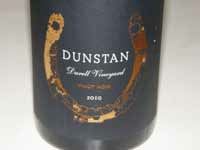 2010 Dunstan Durell Vineyard Sonoma Coast Pinot Noir 14.1% alc., pH 3.50, TA 0.80, 291 cases, $50. A blend of all five clones in the Ranch House Block. Aged 14 months in French oak barrels. Unfined and unfiltered. · Moderately light reddish-purple color in the glass. Pleasingly aromatic with scents of dark berries, toasty oak and mushrooms on the grill. Impressive mid palate attack of dark red and black berry fruit with a hint of brandy-soaked cherries. A little earthiness adds to the appeal. With a satisfying fullness on the palate, full ripeness, and a long finish, this wine aims to please. On top of that, it has a uniqueness that sets it apart.
Foursight Wines: Family Excels with PinotFoursight Wines is a family owned boutique producer of estate-grown Pinot Noir, Sauvignon Blanc and Semillon in the Anderson Valley launched in 2006 by longtime winegrowers Bill and Nancy Charles and daughter Kristy Charles and her winemaker spouse, Joseph Webb. The Charles clan arrived in the Anderson Valley in 1943 to join the regional lumber boom. In 1950, they bought land just east of Highway 128 in Boonville, built a sawmill, and started the Charles Lumber Company. In 2001, Bill and Nancy planted the Charles Vineyard consisting of 15 acres of Pinot Noir, Sauvignon Blanc and Semillon. The grapes from Charles Vineyard were initially sold to Navarro Vineyards, Handley Cellars, Papapietro Perry and Schramsberg. After college, Kristy moved back to the Anderson Valley with Joseph who became the winemaker for Foursight Wines. Joseph has a degree in wine business from Sonoma State University and apprenticed in winemaking at Sebastiani, Landmark Vineyards and Joseph Swan Vineyards. Kristy has been active in the Anderson Valley Winegrowers Association and the Anderson Valley Pinot Noir Festival. The winery’s tasting room, which opened on Highway 128 near Boonville, was designed and built by Bill Charles from lumber grown, harvested and milled on the Charles family ranch. The tasting room is open Thursday through Sunday from 10:00 to 4:30 except for June 20-24 and January 1-24. Private tasting appointments with winemaker Joseph Webb can be arranged in the Foursight cellar (Thursday through Monday: contact Kristy Charles at 707-895-2889). The Pinot Noirs have been consistently impressive and 2010 is no exception. They are sold through a Wine Club and the winery’s website online store at www.foursightwines.com.
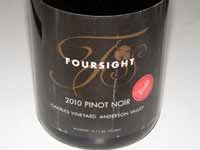 2010 Foursight Wines “Zero New Oak” Anderson Valley Pinot Noir 14.1% alc., pH 3.57, TA 0.62, 168 cases, $38. Released May 2013. Aged in 2-year-old and older barrels so the emphasis is on the Pinot Noir fruit. Sourced from Charles Vineyard. Clones 777, 115, 114 and Pommard 05. Fermented with 30% whole clusters, 100% wild yeast, and wild MLF cultures. Punchdowns are done by hand, the wines are pressed in a traditional, wooden basket press, and aged in French oak barrels until bottling with no racking. · Medium reddish-purple color in the glass. No new oak, but still has a subtle oak note in the aromas and flavors. The nose offers scents of dark berries and grape jelly. Plenty of black grape, black cherry and raspberry flavor with a striking persistence on the huge, very long finish. Balanced and silky on the palate, this is a satisfying wine. Very good.
2010 Foursight Wines Charles Vineyard Anderson Valley Pinot Noir 14.1% alc., pH 3.59, TA 0.62, 170 cases, $46. Released May 2013. Crafted from all four clones grown in the estate vineyard: 777, 114, 115 and Pommard 05. 30% whole clusters, native yeast fermentation and native MLF. Aged in 40% new French oak barrels. · Moderately light reddish-purple color in the glass. Aromas of cherries, forest floor and the slightest oak. Lighter than the 2009 version of this wine and very similar in flavor but with a redder fruit profile. Red cherries are most evident with a bright backbone of citrusy acidity and a juicy finish. Very approachable and easy to drink. Maybe comfortable is the best word. A righteous food wine. Very good.
2010 Foursight Wines Charles Vineyard “Clone 05” Anderson Valley Pinot Noir 14.3% alc., pH 3.71, TA 0.58, 125 cases, $49. Released May 2013. Produced every year since 2007. 30% whole cluster, fermented with wild yeast and wild MLF. Aged in 50% new French oak barrels. Unfined and unfiltered. · Light garnet color in the glass. The wine is quite light in weight, with aromas and flavors of red cherries and raspberries. Oak plays a significant role with aromas of oak spice and espresso. Very elegant with gossamer tannins and bright acidity. More intensely flavorful than one would expect from the light color. Good.
Artisan Winery Weekend, June 29 & 30, 2013. Visit Foursight and other family owned wineries along Highway 128 with open houses, food, special releases and one time only deals. Foursight is teaming up with Aquarelle Restaurant for a series of “Wine Bar Nights” at the Foursight tasting room. Small bites paired with Foursight wines. Fridays, May 31, July 19 and August 2.
COBB Wines: No Wine Before Its TimeMany wineries are now offering the 2010 and even 2011 vintages, but Ross Cobb believes in patience. Despite the demand for Cobb wines from mailing list members and restaurants, Ross chose to age each of the following 2009 vintage Pinot Noirs for 20 months in barrel and an additional two years in bottle. The wines are just now being released to restaurants. Ross says,”Aging our Pinot Noirs for a total of almost four years is extremely expensive, but because we make our wines in very small amounts, we are able to do it. Being patient gives our wines time to fully integrate. We know that when a restaurant receives our wines, they may pour them right away, which is why we want them to be showing their absolute best.” Ross crafts elegant, lower alcohol Pinot Noirs from far Sonoma Coast vineyards. The grapes are typically picked at lower Brix, native yeasts are used for fermentation, some whole cluster is incorporated, the wines are aged with a modest amount of new French oak and released unfiltered. The wines are known to be aromatic. Ross notes, “I aspire to make wines where you will want to smell your empty glass for a half hour after you’re finished.” I reviewed some of these wines a while back, so it was interesting to see how they show now. When I opened the four wines and poured them into glasses, the room was filled with sweet Pinot perfume. The wines were juicy, with good acidity, balanced tannins, showed very little or no oak imprint, and were impeccably balanced. They are ready to enjoy now, but will age beautifully due to the balance. Cobb wines are sold primarily through a mailing list with limited restaurant placement. Annual production is about 1000 cases of Pinot Noir and Chardonnay. Visit www.cobbwines.com.
2009 COBB Coastlands Vineyard Sonoma Coast Pinot Noir 13.0% alc., 295 cases, $70 ($150 magnum). This 15-acre vineyard was planted in 1989 by Ross’s father, David, and his mother, Diane, and is one of the oldest vineyards on the extreme Sonoma Coast. Elevation ranges from 900 to 1,200 feet and sits on a ridge overlooking the Pacific Ocean four miles to the West. Periods of spring rain or heavy fog can lead to very low yields, and in some years is virtually nonexistent. Yield in 2009 was less than 1 ton per acre. Aged 20 months in 35% new French oak barrels. · Medium reddish-purple color in the glass. Highly aromatic, offering scents of dark red cherries and berries, bark, root beer and clove. Tasty core of dark red cherries with subtle accents of animale, tobacco and tar. Modest in weight with firm, dry tannins, and finishing with good power and a lively cut of acidity. Showing much better than previously reviewed six months ago. Very good.
2009 COBB Rice-Spivak Vineyard Sonoma Coast Pinot Noir 13.0% alc., pH 3.29, 295 cases, $70 ($150 magnum). About six miles inland from the Pacific Ocean near Sebastopol, this vineyard is planted to Dijon clones and Swan selection in Goldridge sandy loam soils with volcanic ash. 25% whole cluster. Aged 20 months in 35% new French oak barrels. · Moderately dark reddish-purple color in the glass. Lovely perfume evolves over time in the glass, revealing aromas of darker cherries and berries, forest floor, praline and subtle oak. Intensely fruity carrying royally through the mid palate and finish, showing the most body of the wines tasted here. Attractive finesse, with mild tannins, and a lively citrus-infused ending. Very good (+).
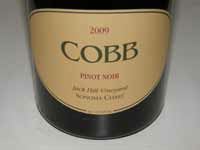 2009 COBB Jack Hill Vineyard Sonoma Coast Pinot Noir 13.5% alc., 140 cases, $70 ($150 magnum). A 2-acre vineyard situated on a steep slope overlooking the Freestone Valley near Occidental. Dijon 115, 667 and 828 planted in Goldridge soils. Aged 20 months in 35% new French oak barrels. · Moderate reddish-purple color in the glass. Darker red and black cherry and berry aromas are featured with hints of forest floor, spice, cigar box, and oak vanillin. Delicious mid weight flavors of cherries, plums and elderberries with an outrageously long and satisfying finish. Beautifully balanced tannins and acidity. Will make any dinner special.
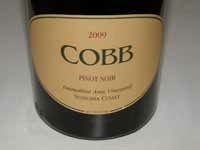 2009 COBB Emmaline Ann Vineyard Sonoma Coast Pinot Noir 13.0% alc., 260 cases, $70 ($150 magnum). A 3-acre hillside vineyard near Occidental. Two Dijon clones planted in Goldridge sandy loam soil. Exposed to the most shade and fog of any of the vineyards Ross works with. Aged 20 months in 30% new French oak barrels. · Moderately light reddish-purple color in the glass. Hi-tone aromas of dark red cherries and berries permeate the air. Ambrosial flavors of dark red cherries, pomegranates, and spice. The most polished wine in the lineup with a silky smooth mouth feel. Finishes with a bold kiss of cherries and juicy acidity. One of the best one night stands you’ll ever have.
Sips of Pinot: Wines Tasted Recentlythis.fmt_tasting_notes(6175,6176,6177,6178,6179,6180,6181,6182,6183,6184,6185,6186,6187,6188,6189,6190,6191,6192,6193): 6184
Rosé and Chardonnay: Recently Sampled Wines
2012 is shaping up as a great vintage for Pinot Noir. There is a surplus of fruit for winemakers to play with, so
expect to see many fine rosés in the marketplace.
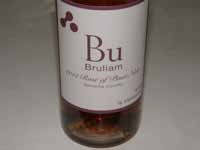 2012 Bruliam Sonoma County Rosé of Pinot Noir 14.5% alc., $20. A saignée of Pinot Noir after 24 hours of skin contact. Fruit is from the Russian River Valley (estate Torrey Hill Vineyard) and Sonoma Coast (Gap’s Crown Vineyard). Fermented and aged in stainless steel kegs after inoculation. No MLF. LIghtly fined for clarity. · Light pink-coral color and clear in the glass. Fresh aromas of strawberries, watermelon, cherry glaze and dried herbs. The flavors echo the nose with some welcome spice. A subtle riff of dried herbs adds an appealing savory accent. The wine is dry and refreshing and not in the tutti fruity genre of rosés. I would drink it with sushi. Very good.
2012 Left Coast Cellars Willamette Valley Rosé of Pinot Noir 13.0% alc., 275 cases, $18, screwcap. Dijon 777 and 667. A saignée of 100% Pinot Noir. 50% aged in neutral French for 5 months and 50% aged in stainless steel for 5 months. · Moderate deep pink hue in the glass. This a more substantial rosé with more color, body and fruit concentration seen in most rosés. I like it for its juicy strawberry, cherry and watermelon aromas and flavors. Pair this with pork tenderloin or Honey Baked Ham. Very good.
2012 Soliste Soleil Rouge Sonoma Coast Rosé de Pinot Noir 13.1% alc., 327 cases, $22. · Moderately light pink coral color in the glass. Aromas of dried cherries, alpine strawberries, melon, and herbs. Fresh flavors of strawberry, pink grapefruit, and orange zest, finishing with a note of tart grapefruit peel. Dry, and easy to like, with a freshness that is the calling card for rosé. Very good.
2012 Waxwing Spring Hill Vineyard Sonoma Coast Pinot Noir Rosé 12.9% alc., 26 cases, $23. Released April 20, 2013. From a cool and windy vineyard situated in the center of the Petaluma Gap. Grapes picked a week earlier that for regular Pinot Noir. A dedicated rosé, not a saignée meant to concentrate a Pinot Noir wine. Clone 777. The fruit was stomped in the bins to release a touch of color into the juice and whole cluster pressed an hour later. The juice was racked after 24 hours and fermented in stainless steel. Aged 5 months in stainless steel. · Pale pink color in the glass. Delicate aromas of red strawberries, cranberries and honeydew. Light, dry and refreshing, with elegant flavors of red berries and cherries, finishing with bright acidity. Good.
There is plenty of buzz in the wine press about a shift in the public’s preference for non-oaked Chardonnay. Don’t count me in that group, for I prefer barrel fermented California Chardonnay and here are a few excellent reasons why. Also check out the Gardener Don Miguel Vineyard Russian River Valley Chardonnay reviewed earlier in this issue.
2011 Paul Hobbs Russian River Valley Chardonnay 14.2% alc., · Light golden straw color in the glass. Aromas of lemon curd, honey, buttered popcorn and oak. Layers of flavors including lemon, white peach, poached apple, spice and caramel with a dry, lemony finish. Oak is used to an advantage. Very Russian River Valley in character. Not for mineral-driven Chardonnay aficionados, but rather fruit and oak forward Chardonnay lovers. I can appreciate the appeal of this style which is very popular. Very good.
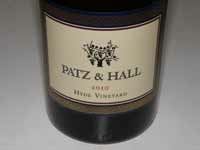 2010 Patz & Hall Hyde Vineyard Carneros Napa Valley Chardonnay 14.2% alc., 1,364 case, $58. Released October 2012. Fifteenth vintage from this vineyard first planted in 1981. This vineyard shines in both hot and cool years. Hyde-Wente selection planted exclusively for Patz & Hall on the best soils at Hyde Vineyard. Very well-drained sandy, clay loam which typically produces low vigor and low yields. Whole cluster pressed, indigenous yeast fermentations, aged sur lie with weekly stirring, 100% MLF in barrel, aged in 52% new Burgundian French oak barrels. Unfiltered. · Light golden straw color and clear in the glass. Perfumey with attractive aromas of lemongrass, honey, pear and fresh air after a rain. Very classy, and of striking quality, with flavors of lemons, apples and oak-driven caramel and honey. Seamless, bone dry and done right. This is a wine that drinks so softly, you want to take another sip right away. Sublime seduction and one of California’s greatest Chardonnays.
2011 WALT La Brisa Sonoma County Chardonnay 14.4% alc., $35. Walt Wines is owned by vintners Kathryn Walt Hall and Craig Hill who partnered with artisan vintner Roger Roessler. A blend of Russian River Valley and Sonoma Coast vineyards (Dutton Ranch and Sangiacomo Vineyard). Old Wente clone. · Moderate golden straw color and clear in the glass. Aromas of lemon meringue, honey, poached pear, stewed apples and fresh cut grass. A solid wine with appealing flavors of vanilla pudding with pineapple, baked pear, nori and a hint of oak. A bright cut of acidity brings the wine to life and leads to a refreshing finish. Good.
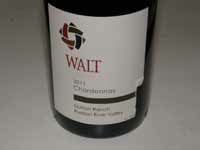 2011 WALT Dutton Ranch Russian River Valley Chardonnay 13.8% alc., 1,009 cases, $60. Dutton Ranch and Sangiacomo Vineyard. Old Wente clone. Native yeast fermentation, unfined and unfiltered. · Light golden straw color and clear in the glass. Shy, but inviting aromas of Asian pear, lemon drop, brewed lemon tea and a hint of juicy fruit. A statuesque wine that has a charming restraint but offers a very pleasurable array of flavors including lemon, pear, and green apple. No imposing oak to spoil the experience. This is a wine that unfolds slowly, showing a different nuance a little at a time. Very good.
There is a mini-surge of curious interest in Pinot Noir Blanc. Every Pinot Noir event I have attended this year has had a tasting of this new wine fad and I see there is another one at the upcoming Anderson Valley Pinot Noir Festival Technical Session. One of the best and reasonably priced examples is this offering from Left Coast Cellars. I first tasted it at World of Pinot Noir and was so captivated, I bought a few bottles for my own cellar.
2012 Left Coast Cellars White Pinot Noir 13.5% alc., 200 cases, $20, screwcap. Made from freerun juice of Pommard and Wädenswil Pinot Noir grapes. Aged 5 months in stainless steel. · A multitude of aromas and flavors including pear, tropical fruits, and white peach. Brisk, juicy, fruity and refreshing. Delightful slightly chilled as an aperitif. Very good.
Pinot BriefsWorld of Pinot Noir Burgundy Presentation Don Kinnan’s slide presentation from “Terroir: The Soul of the Côte d’Or” held on Saturday, March 2, 2013, is now available for viewing on the World of Pinot Noir website at www.wopn.com. The audio recording of Kinnan’s seminar is also available on both the World of Pinot Noir website and Grape Radio at www.graperadio.com. World of Pinot Noir email subscribers receive a 10% discount on the French Wine Society’s new Bourgogne Master Level Program. 16th Annual Anderson Valley Pinot Noir Festival Technical Conference The schedule of the full day Technical program on May 17n has been announced. Visit www.avwines.com for information on the entire event which will be held May 17-19, 2013. Greg Walter of Pinot Report will discuss the current state of Pinot Noir; Glenn McGourty, a viticulture and plant science advisor will give a report on the state of viticulture in Mendocino County and agricultural water use in Anderson Valley; a comparative tasting of Pinot Noir Blanc from New Zealand, Oregon and Anderson Valley will be offered; I will present a talk on Pinot Noir Suitcase Clone “828”; Mel Knox, broker for Tonnellerie Francois Frères and Tonnellerie Taransaud, will speak on barrel selection for Pinot Noir; a Riedel glass comparative tasting panel will follow; and a focus tasting panel with Brad Wiley will present wines of Wiley Vineyards. The Technical conference will include a lunch in the Fairground’s Redwood Grove including buffalo burgers and a selection of local wines.
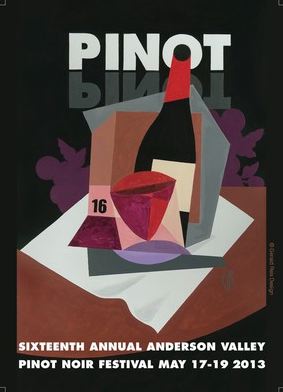 2013 Carlton Crush Festival Registration is now open for the Carlton Crush competitions at the 2013 Carlton Crush Harvest Festival. The event will be held on September 14, 2013, to celebrate the unique culture of Carlton and Yamhill County. Live music and entertainment, food and wine, an Artist’s market, and helicopter rides. Registration forms for the Grape Stomp, Barrel Rolling Race and Wine Thief Relay are available on the event’s website at www.CarltonCrush.com.
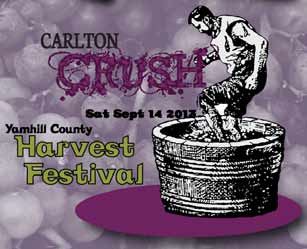 9th Annual Marin Wine Celebration An opportunity to taste newly released Marin-grown wines including some library selections, poured by vintners and growers at the historic Escalle Winery in Larkspur. These small lot wines are truly hand made and reflect the unique bounty of Marin County agriculture. Participating wineries include Bailiwick Wines, Burning Bench Cellars, Couloir Wines, DeLoach Vineyards, Dept C Wines, Dutton-Goldfield Winery, Easkoot Cellars, Kendric Vineyards, McEvoy Ranch, Pacheco Ranch Winery, Pey-Marin Vineyards, Point Reyes Vineyards, Sean Thackrey, Skywalker, and West Wind Wines. Saturday, May 11, 2013, from 3:00 to 7:00. Cost is $55. Visit www.malt.org. Proposed Sta. Rita Hills AVA Expansion A petition to extend the eastern boundaries of the Sta. Rita Hills AVA has recently been submitted to the TTB by Patrick Shabram. The Sta. Rita Hills AVA lies within the larger Santa Ynez Valley AVA, an east-west transverse valley with a continuum of climatic and geological features influenced by its opening to the Pacific Ocean. It spans over 31,000 acres at the far western end of the Santa Ynez Valley and has one of the longest growing seasons and coolest climates among winegrowing regions of California. The current and original AVA boundaries were carefully determined in 2001 by the original petitioners based on patterns of daily oceanic fog and temperature data. The eastern boundary to the AVA is a north-south range of hills that alters the sea fog pattern and brings an increase in daily temperatures moving east from this boundary. In the opinion of the original petitioners and the Sta. Rita Hills Winegrowers Alliance (SRHWA), it is imperative that the cool climate environment for winegrowing is maintained. A study of the data in the petition submitted by Mr. Shabram will be reviewed by the SRHWA board, but at this time the SRHWA stands by the integrity of the original and current boundaries. Visit www.staritahills.com. Sta. Rita Hills Wineries on the Road SRHWA members will be sharing their new vintages at three locations throughout California: April 29 at The Wine House in Los Angeles, May 13 at The Firehouse Fort Mason Center, and May 14 at Stark’s Steak House in Santa Rosa. The evening tastings are open to the public. Participating wineries include Cargasacchi, Cold Heaven, Clos Pepe, D’Alfonso Curran, Dragonette, Fiddlehead Cellars, Flying Goat Cellars, Hilliard Bruce, Huber, Kessler-Haak, Lindley, Liquid Farm, Longoria, Pali Wine Company, Rozak, Siduri, The Hitching Post, Transcendence, and Zotovich Cellars. Visit www.staritahills.com. 2013 Pigs & Pinot Recap On March 22-23, Chef Charlie Palmer’s Eight Annual Pigs & Pinot Weekend was held at Hotel Healdsburg and Dry Creek Kitchen. Honored guest chefs were Jose Garces, Dean Fearing, Elizabeth Falkner, and Craig Stoll and top Pinot Noir winemakers lent their talents to raise funds for Share Our Strength and local Sonoma County charities and organizations. The Pinot Cup Winner was the 2010 Roth Estate Sonoma Coast Pinot Noir and the runner up was the 2011 Te Kairanga John Martin Reserve Martinborough New Zealand Pinot Noir. The Sommelier Smackdown Winner was the 2011 Lucia Soberanes Vineyard Santa Lucia Highlands Pinot Noir and the runner up was the 2010 Bergström Homage Willamette Valley Pinot Noir. The Gala Dinner at Dry Creek Kitchen featured a signature creation from Palmer and the visiting master chefs, paired with Pinot Noirs from De Loach Vineyard, Domaine A.F. Gros, Kosta Browne, Martinelli Winery and Sea Smoke. Hotel Healdsburg’s sister property h2 Hotel offered a Swine and Wine dinner the same night featuring some of the Bay Area’s most innovative chefs and the Pinot Noirs of Cobb Wines and VML Winery. Join the mailing list to try to get a coveted ticket to next year’s Pigs & Pinot event: www.hotelhealdsburg/pigsandpinot/.
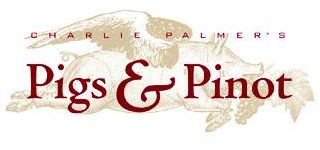 Prodigal Ceases Production Steve and Mary Russell have announced that after wrestling with a tough decision for the last two years, they decided to produce no more wine. They will be concentrating instead on their Quinta Santa Rosa Vineyard and their bucket list. Their excellent wines are on sale at half price at the tasting room in shared space with Standing Sun Wines, 92 Second St., Unit D, Buellton, CA. Pinot Leaf Curl and Pinot Leaf Roll Take Their Toll Pinot leaf curl has been seen more often in Sonoma County’s Pinot Noir vineyards during the cool vintages of 2010 and 2011. Researchers have theorized that it is due to a nitrogen disorder that leads vines to produce the toxic compound putrescine and seems to be related to vineyard location and low spring temperatures. Another condition, leaf roll, is due to a virus. Sadly, it has taken its toil on the Old Vineyard at Hirsch Vineyards in Cazadero, on the far reaches of the Sonoma Coast. 2011 was the last year for most of the Old Vineyard as yields had declined significantly. Pinot Noir from the Rocky Mountains? A worldwide analysis of climate change and its affect on winegrowing appeared recently in the Proceedings of the National Academy of Sciences. The study suggested that wine production will shift to new regions as climate change makes some of the existing winegrowing regions unfavorable. Nine major wine producing areas were studied including California. An area that may prove suitable for winegrowing in the future is in the Rocky Mountains near the Canadian-United States border. the analysis predicted that many California vineyards will become unproductive. North Coast grape farmers remain optimistic about finding ways to produce premium crops if temperatures rise as the study predicts (Press Democrat, April 11, 2013). “The work of grapevine researchers and the adaptability of farmers as well as the region’s proximity to the Pacific Ocean will help prevent the demise of Wine Country.” Fingertip Alcohol Scanner As reported in The Drinks Business (April 9, 2013), the AlcoSense TruTouch 2500 was launched at the Commercial Vehicle show in Birmingham, England. The new technology can determine a person’s level of intoxication in seconds with just a touch of a finger and is 96% accurate. The scanner uses a near-infrared light to measure blood alcohol content in the skin through contact with an optical pad. The system can also be used to determine the identity of the user. The TruTouch is not yet certified in the UK. Visit www.AlcoDigital.co.uk.
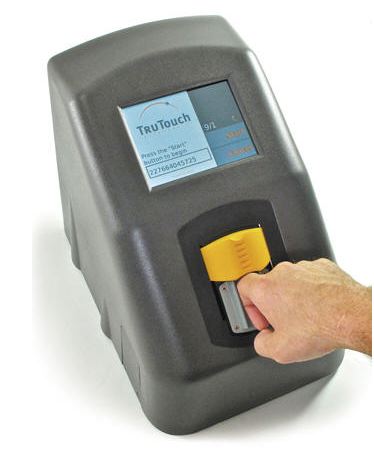 2012 Record Wine Sales in United States According to The Financial ( www.finchannel.com, April 8, 2013), wines sales in the U.S. from all U.S. states and foreign countries increased 2% from the previous year to a new record of 360.1 million 9-liter cases with an estimated retail value of $34.6 billion. California wine accounted for 58% of the sales. California wine shipments to all markets in the U.S. and abroad reached 250.2 million cases. It is predicted that wine consumption in the U.S. will continue to increase over the next decade. Chardonnay is still the most popular varietal (21% share of volume), followed by Cabernet Sauvignon, Merlot and Pinot Gris in that order. Direct-to-Consumer Wine Shipments The 2013 Wines & Vines and Ship Compliant Direct Shipping Report found that the value of direct-to-consumer shipments from American wineries increased to $1.46 billion in 2012, and was greater than the total value of U.S. wine exports. The 10% increase in sales of direct-shipped wines continues the sales channel’s history of outpacing the growth of overall wine sales in the U.S.. More than 2.17 million 9-liter cases of wine were shipped direct to American consumers in 2012, a 7.7% increase over the year before. The 2013 Direct Shipping report is available free for downloading by visiting www.shipcompliant.com/shippingreport. Non-Sulfured Wines May Become Available According to The Drinks Business (April 16, 2013), a company in Italy, Integrapes, is testing an antioxidant and antibacterial preservative derived from grape pips that it believes is as effective as sulfur. In addition, the wine is said to retain more of wine’s natural aromas, particularly the delicate floral aromas that sulfur can obscure. The compound is derived from the polyphenols found in grape seeds and the resulting solution is then added to the must and wine at various stages of the winemaking process. Essentially, one liter of the preservative is added to every 20 hectoliters of wine at the end of alcoholic and then malolactic fermentation and then before bottling. The resulting wine supposedly has the potential to age, unlike non-sulfured “natural” wines (the company producing the preservative has followed wines for seven years). The product has been endorsed by Italy’s leading wine writer, Luca Maroni, who is collaborating in the testing. Why Indicate pH & TA in PinotFile Wine Reviews? You won’t see these figures in reviews from any other wine publication, but I believe this is just as relevant as the alcohol percentage or barrel aging regimen. It gives the consumer some valuable additional information that can be used as an adjunct to making choices about which wines to drink. Thanks to Dan Goldfield’s Dutton Goldfield Newsletter and Gary Farrell in his Alysian Wines Newsletter for the following explanations. Acidity is a measure of the breakdown of products of water in solution. In other words, a small amount of water is broken down to H+ (hydrogen without its electron, which is negatively charged, hence the positive charge here) and OH- (the oxygen keeps the extra electron, thus the negative charge). H+ is the active agent of acidity so the higher the H+ concentration, the more acidic the solution. pH is a measure of the strength of acidity. Since pH is the negative log of the H+ concentration, the lower the pH, the more acidic the solution. Pure water has a pH of 7. Blood is 7.2 and bleach is 9. On the other end, coffee is about 5, lime juice is 2 and stomach acid is between 1 and 2. Wine tends to fall between 3 and 4, but from pH 3 to pH 4 there is a tenfold reduction in H+ so this variation is significant. pH is a critical measurement during winemaking and ideally should be below 3.60 for sulfur dioxide to be effective during the winemaking process. Lower pH juice ferments cleaner and produces more favorable flavor. A higher pH will increase the chance of Brettanomyces and the growth of spoilage organisms. The average red wine in California with a finished pH of 3.6 requires 50% more free sulfur than a finished red wine at pH 3.4 to offer equal protection. Lower pH is associated with an intensified red wine color, lower pH wines tend to age more slowly, and the brightness and tart balance of a wine comes from its acidity. Acidity also affects the way a wine shows oak aging. Higher acid wine tends to show wood more slowly and changes the choices a winemaker might make in that regard. Low acid (high pH) wines can be flat and lack freshness. Wines with generous acidity are more likely to be crisp, vibrant and refreshing. The other common way of expressing acidity is the titratable acidity or TA. This test measures the total of all acids present. The perception of acidity in a wine is related to the TA and not pH. TA produces the acid sensation in the mouth and is most critical for mouth feel. pH and TA values do not run parallel, and a wine can have a high pH and a low TA or vice versa. However, wines with higher total acidity generally exhibit lower pH values. Higher TA tends to make the astringency of a wine more apparent, as does higher alcohol. The balance of TA with alcohol, which is perceived as sweet, is very important to the flavor profile of a wine. Pinots in the Marketplace How much highly desirable California Pinot Noir is bought to sell rather than bought to drink? Every day, I receive offers from resellers to buy Pinot Noir on the secondary market, often with a significant markup over the original release retail price. There is a remarkable amount of Pinot Noir for sell produced by prominent, highly regarded wineries, and I wonder how much of this wine is being drunk? I see more resell offers for Williams Selyem Pinot Noir than any other California Pinot Noir producer, but Kosta Browne, J. Rochioli, Rivers-Marie, Rhys and Marcassin are frequently resold as well. Much of this resell activity stems from the fact that all these producers highly allocate their wines to mailing lists that are full, so their is a segment of wine enthusiasts for whom their only access to these wines is to buy them on the secondary market. The result is that some buyers on the mailing lists buy to sell, and many on the outside buy at a premium to drink. U.S. Dept of Health and Human Services Most Recent Data (2008) Oregon is #15 among U.S. states in per capita consumption at 4.3 gallons, California is #9 at 4.9 gallons, and District of Colombia is #1 at 8.8 gallons. Apparently our politicians love wine. Second Annual Passport to Pinot Russian River Valley Winegrowers (RRVW) has announced its Second Annual Passport to Pinot Barrel Tasting Weekend on June 8-9, 2013, from 11:00 to 4:00. More than 30 wineries will share exclusive offerings with ticket holders including barrel tastings, futures purchases, library tastings, food pairings, artist demonstrations and entertainment. Tickets are $65 for the weekend that includes both days. A limited number of Sunday only and Designated Driver tickets are available. For information and to purchase tickets, visit www.rrvw.org or call 877-650-3717. The documentary, "From Obscurity to Excellence: The Story of Grapes & Wine in the Russian River Valley" will be shown on June 7 at the Vintner's Inn in Santa Rosa following a wine reception. See a preview of the film at www.russian-river-valley.com. Tickets may be purchased online at www.rrvw.org/passport-to-pinot. Memorial Weekend in Oregon Wine Country The traditional Memorial Weekend in the Wine Country will be held in the Willamette Valley May 25-27, 2013. Many Oregon wineries that are not open to the public will be hosting open houses this weekend. Hosted by the Willamette Valley Winegrowers Association, a guide is available at www.willamettewines.com or use the Mobile Wine Tour app that is compatible with all smart phones at www.WillametteWineMap.com. |